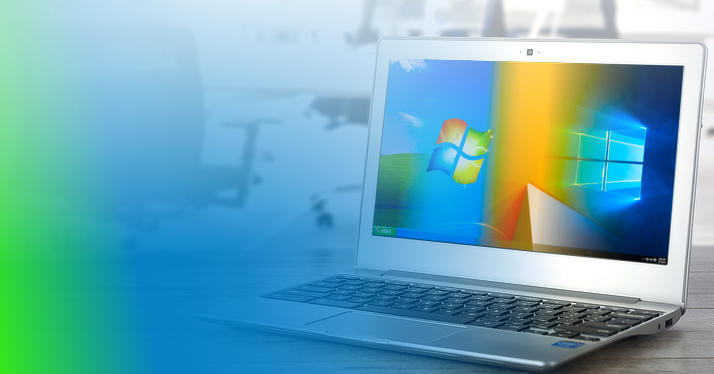All software products have a shelf life. When that time comes, support and updates either get abandoned entirely, or there is a planned gradual downward slope designed to give businesses time to migrate to newer supported software.
Microsoft, to its credit, uses the latter model and the downward slopes they plan for are long and well signposted. Sometimes the support is even extended past the initially advertised retirement date for a particular software product. But eventually, the end of the slope is reached.
There’s no such thing as a desktop migration
Windows 7
Windows 7 is about to reach the bottom of the support ramp. After the 14th January 2020, there will be no more regular updates or security patches supplied for Windows 7 in the monthly Microsoft update process. There will be access to critical security updates for organizations who want to pay Microsoft. But that’s designed for large organizations with deep pockets such as governments and substantial multi-national corporations. It’s not a feasible route for most businesses.
Security Considerations
Security is vital in the current business world. No one wants to fall foul of a cyberattack. The reputational and operational damage are bad enough on their own, but add in the potential for crippling sanctions under GDPR and other regulations, then keeping IT systems secure is a top tier business process.
What should you do now that regular Windows 7 security updates are ending in January? The Microsoft response is to migrate to Windows 10. Which is fine, but it is not as simple as that for many organizations. Their current PC’s, bespoke business applications, and PC controlled machinery will be crucial to productivity and operations, and the disruptions of a Big Bang migration from Windows 7 to Windows 10 may be a considerable burden. Plus, it is not an activity to be rushed in the three months left on Windows 7 support.
Put some Scense into your Migration Plan
Appixoft can help you build an ‘extended support ramp’ with our Scense technology. By deploying the Scense Managed Workspace, you abstract the applications, printers, data, settings etc. for each user. Scense decouples the productivity workspace for each user from the underlying device and operating system. Each user gets their own workspace irrespective of the device they log in on, and this means that migrations from Windows 7 can be done at a sensible pace without disruption and loss of productivity.
Users can logoff from their Windows 7 workstation and logon to Windows 10 and they will still get all their business applications and their workspace. And IT can make sure that the migration is done correctly without having to worry about user downtime. The business can continue at full productivity while a rolling migration from Windows 7 takes place. And in the future, when older Windows 10 releases reach their end of life, there will not need to be a Big Bang migration then either if you have Scense in place.
What Does Scense Deliver
Full details of the benefits and features of Scense are available on the product pages. We won’t repeat that info here but will emphasize that deploying Scense gives any organization a reliable workspace architecture that can adapt as business needs change. It also makes it much easier for IT departments to deliver the applications staff need to do their jobs while also making them more productive and easier to support.
Conclusion
Whether you are delivering applications to users in business, healthcare, industry, or education, Scense Workspace Management’s application delivery toolset will allow you to provide them easily and make your users happier and more productive.
At the same time, your IT teams will be freed up to work on more interesting projects that can help drive your organization forward. Contact us today to find out more, and to simplify your application delivery, and operating system migrations.

